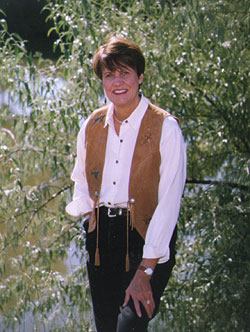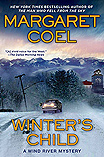 |
 An Interview with Margaret Coel
An Interview with Margaret CoelTell the readers a little about yourself. I'm a born and bred westerner and a fourth-generation Coloradan. Even though I grew up a city girl in Denver, I spent most of the summers in the mountains and out on the plains. I still prefer to be outdoors. I ski as many days as possible every winter and hike and play competitive tennis in the summers. As a westerner, I've always had a strong sense of place. You could say the West itself, with its colorful past and unique cast of characters, inspired me to tell some of its stories. What made you choose the mystery genre? I simply followed the old maxim: write what you love to read. Since I always loved curling up with a good mystery, I thought it would be fun to write one. I enjoy reading mysteries that offer something more than a puzzle. I want to be transported into another world and learn something new. For that reason, I enjoy Tony Hillerman's look at the Navajo world, Sharyn McCrumb's Appalachian world, Thomas Harris's Seneca world, James Doss's world of the Utes, Ann Ripley's garden universe and John Dunning's book world. What fun to read! Aside from mysteries, I'm an eclectic reader. I delve into history, biography, poetry, and lots of novels. I always try to "read up." That is, I try to read the best novels I can find because I'm always trying to improve my own craft. What's it like to write novels? Where do you get your ideas? Writing novels is the most fun I've ever had. Many of my plots come straight out of history. The Eagle Catcher was about the way Indian people were defrauded of their reservation lands; The Story Teller dealt with the ledgerbooks — the books written in pictographs by the Plains Indians; The Lost Bird was about the heartbreaking way in which Indian babies were stolen from their parents; The Spirit Woman is all about the story of Sacajawea, the Shoshone woman who went on the Lewis and Clark expedition; The Shadow Dancer weaves in the story of Wovoka, the prophet of the Ghost Dance Religion of the 1880s. I'm fascinated by the way past injustices percolate into the present and must be dealt with on new terms. And just reading the newspaper every day gives me more ideas for plots than I could ever dream up on my own. The plot for The Dream Stalker came from articles about the federal government's efforts to build nuclear waste storage facilities on Indian reservations. I hit upon the plot for The Ghost Walker after reading about illicit drug labs on reservations. Okay, so you have the idea for a plot. Then what? Then I spend several weeks mapping out the plot. I come up with the various "plot events," then place them into chapters. By the time I start the actual writing, I have the novel well in hand. The writing then goes pretty fast. Of course, as I'm writing, the plot can take a turn I hadn't expected, or the characters can decide they want to do something other than what I had planned. I always allow such surprises to come into play. It makes writing fun and exciting. Usually I'm able to work the surprises into the master plan without having to make too many substantial changes. How do you get inspired to write? Inspiration, I have found, comes from the writing itself. If I waited to be inspired before I sat down at my computer, I would never sit down. I go to work on my novel at 8:30 a.m. five days a week and write five or six hours—whether I feel like it or not. I've learned that the writing comes first, and the inspiration follows. How did you create the characters of Father John Aloysius O'Malley (what a great name!) and Vicky Holden? Father John actually came to me in a dream after I'd decided to write a mystery about the Arapahos on the Wind River Reservation. The only thing I knew at first about my sleuth was that he or she should be an outsider, since I am an outsider. I wanted a sleuth who would come into the Arapaho culture, learn about it, and come to appreciate it—as I did. An outsider sleuth might be an FBI agent, doctor, teacher or social worker, but none of them caught my imagination. And then, one night in my dreams, here was this priest. He's been with me ever since. Every summer, when I visit the Wind River Reservation, I half expect to meet him. And there is the actual mission on the reservation, St. Stephen's Mission, run by the Jesuits since 1878. So having a mission priest as the sleuth was realistic. My other sleuth, Vicky Holden, an Arapaho attorney, popped into my mind because I very much wanted to tell part of each story from the point of view of an Arapaho. Like Father John, Vicky seems very real to me. I think of her as going about her life, practicing law in a little one-woman office in Lander and always trying to help her people. What's next for Father John and Vicky? In Killing Raven, which will be published in September, 2003, a casino has come to the Wind River Reservation and Father John and Vicky find themselves enmeshed in graft and corruption that threatens to destroy the community. They're also up against some very bad guys in this novel—professional bad guys who think nothing of shooting someone in the head while finishing off a cup of coffee. What advice do you have for beginning writers? Be persistent. Work hard at your craft, and stay with it. Don't ever give up. No matter how many rejection slips you collect, keep writing. The offices of the best writers I know are papered with rejection slips. I have quite a collection myself. Anything else you'd like to tell you'd like to tell your readers? Two words: Thank you. Or, Ho'hou", as the Arapahos would say. One of the biggest thrills for a writer is having someone tell you they enjoyed your book. It never ceases to amaze me that my "dream people" and their stories have taken on their own existence and live in the minds of people I have never met. It's wonderful. So what can I say to readers except "thank you" for allowing my stories into your lives. Read another interview/article. Photo Credit: Valerie Meadows |
|
|
|
